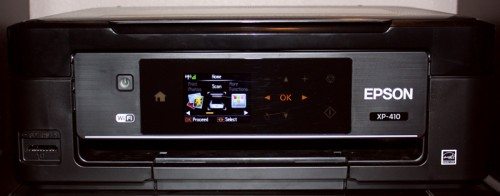

#Epson xp 410 wireless setup Pc
Place your printer close to the PC you want to connect to.Ĭonfirm the connection and network setup of the PC or other device.Ĭonnection using the EpsonNet Setup is available.Ĭontact your network administrator for assistance.If it is turned off, turn it on and perform network setup for your printer again. Check that the PC you want to connect to is turned on.Contact your network administrator for assistance. Confirm that the wireless network name (SSID) of the PC you wish to connect is set up correctly. Perform Ad Hoc setup for your PC, and then perform network setup for your printer again. If you want to set up an Ad Hoc connection, you need to set up Ad Hoc for your PC first.If you have set up the network using WPS, check whether or not your access point supports WPS.Your wireless network name (SSID) is displayed in C (Network Status) under Network Name (SSID). If you have manually entered the wireless network name (SSID), confirm whether or not your wireless network name (SSID) is correct.Place your printer close to the access point.If it is turned off, turn it on and then perform network setup again. Check that the access point is turned on.Confirm that the router/access point is turned on and the wireless network (SSID) is set up correctly. Messages and solutions for the check itemsġ. Spending 23.6 cents for a four-color page is pricey even in the entry-level category.Click the items below to go to the messages and solutions. In the smaller standard capacities, black is a whopping 7.4 cpp, and each color 5.4 cpp. That’s an above-average 17.4 cents for a four-color page. The 500-page, $30 XL black works out to 6 cents per page (cpp), while the $17, 450-page cyan, magenta, and yellow XL cartridges are 3.8 cpp each. Here’s where you have to take care: The XP-410’s ink is very expensive. Scan times were among the slowest we’ve seen in a few years (as they were for this product’s predecessor, so this is a feature, not a bug), but the scans themselves were good. On the PC, a smaller 3-by-5-inch photo took 16 seconds at default settings on plain paper, and 70 seconds at the Photo setting on Epson’s own special stock. Color photos took considerably longer-especially the full-page photo we print on the Mac, which took three minutes to print at best settings. Documents consisting of plain, black text and small monochrome graphics printed at an aggregate 6.6 pages per minute (ppm) on the PC and 6.4 on the Mac. We use Hammermill LaserPrint as our “plain” paper and the vendor’s own stock for photos. Your results will vary, of course, depending upon the quality of the paper you use. The edges look classically inkjet-soft, but not fuzzy. The XP-410 also produces surprisingly good text in all manner of fonts. A color copy on plain paper was gorgeous. Even photos printed on our plain paper were pretty nice: a little grainy, but with decent brightness and accuracy. Fleshtones, though pinkish were still credible. Photos showed good overall color accuracy and realistic contours and shadows. The installation CD has plenty of room why not just put them there? It’s a puzzler, but common on Epson’s lower-cost machines.Įpson’s gently pink color palette works to the benefit of most images.
#Epson xp 410 wireless setup mac os x
One annoyance is the exile of the primary user guide and the Mac OS X drivers to Epson’s Web site. The scanner lid does not telescope to accommodate thicker material, so scanning a book would be awkward. All these pieces use somewhat flimsy, rattly plastics, as is typical for products at this price point. What you get for the price is a compact, simply designed machine with a flatbed letter/A4 scanner on top and a 100-sheet rear vertical feed. (Just be honest with yourself about this, or you’ll regret it later.) So for those who truly are printing less, the XP-410 could be a good standby machine. Also, while it may seem counterintuitive, if you don’t print much, the cost of the ink matters less.

The $99 Epson Expression Home XP-410 Small-in-One does not solve any of these issues-and its inks are, in fact, quite pricey-but it does offer surprisingly good output quality along with basic multifunction features. Consumers are posting online more, printing less-and losing their patience with pricey ink cartridges. Dell, Kodak, and Lexmark have all quit the business in the past year. The color inkjet printer market is running on optimism these days.


 0 kommentar(er)
0 kommentar(er)
